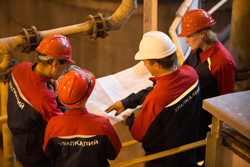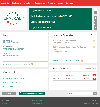Uralkali Announces 1Q 2015 Key Figures

Uralkali (LSE: URKA; the Company), one of the world’s largest potash producers, announces its unaudited IFRS key figures for the three months ended 31 March 2015.
1Q 2015 TOP LINE AND OPERATIONAL HIGHLIGHTS:
- Revenue down 17% y-o-y to US$720 million
- Net revenue down 6% y-o-y to US$612 million
- Production down 8% y-o-y to 2.7 million tonnes of potassium chloride (KCl)
- Sales volumes down 17% y-o-y to 2.53 million tonnes of KCl
- Average export price up 19% y-o-y to US$256 per tonne of KCl
1Q 2015 CORPORATE HIGHLIGHTS:
- In March, Uralkali’s Board of Directors approved a revised Development Strategy for
2015-2020 as a result of a strategic review following the Solikamsk-2 accident. The updated programme is focused on capital intensive investment in the Company’s production facilities in order to sustain Uralkali’s industry leadership. Total capital expenditure will amount to approximately RUB 300 billion between 2015 and 2020
SIGNIFICANT EVENTS AFTER THE REPORTING PERIOD:
- In April, Uralkali signed a US$530 million
4-year Pre-Export Facility with the option to increase the amount up to US$800 million. In June, the amount of the facility increased to US$655 million - In April, the Board of Directors adopted a new discretionary dividend policy providing flexibility to the Board of Directors in determining the amount of dividend payments
- In April—June, Uralkali executed a tender offer for its shares and GDRs, purchasing 11.56% of Uralkali’s outstanding common shares for a total amount of US$1.09 billion
Dmitry Osipov, Uralkali CEO, commented:
In the first quarter, lower demand across the majority of our key markets resulted in a fall in net revenue of approximately 6% year-on-year as the agricultural sector felt the adverse effect of currency fluctuations, lower crop prices and farmers using their existing stocks.
Still, we remain confident about the long-term strong prospects of the potash industry. In March, following the Solikamsk-2 accident we reviewed and adopted an updated capacity development programme to ensure we maintain our industry leading position going forward.
The key 1Q 2015 figures were as follows:
|
Q1 2015 |
Q1 2014 |
FY 2014 | |
|
Revenue (US$ million) |
720 |
862 |
3,559 |
|
Net Revenue (US$ million)1 |
612 |
649 |
2,785 |
|
Average export potash price, FCA, USD |
256 |
215 |
233 |
|
Production (KCl, million tonnes) |
2.70 |
2.93 |
12.13 |
|
Sales volume (KCl, million tonnes) TOTAL — Domestic — Export |
2.53 0.48 2.05 |
3.05 0.49 2.56 |
12.28 1.92 10.37 |
Business and Financial Review
In 1Q 2015, production at Uralkali fell as a result of decreased output capacity following the accident at the Solikamsk-2 mine. Sales volumes also dropped year-on-year due to subdued demand in the Company’s key markets, though higher prices contributed to the revenue of US$720 million and net revenue of US$612 million.
Following the Solikamsk-2 accident, the management and the Board of Directors reviewed the Company’s capacity development programme. The decision was taken to focus on specific projects to be implemented by 2020 with a total investment budget of RUB 300 billion, which will increase Uralkali’s total capacity to 14.4 million tonnes of KCl. The main projects are as follows: construction of the Ust-Yayvinsky mine; capacity expansion at Solikamsk-3 — construction of shaft No. 4; construction of a new mine at Solikamsk-2; KCI loading increase at Berezniki-3 and Berezniki-4; and further development of granulation facilities.
Uralkali is expanding load capacity at Berezniki-3 and Berezniki-4, which will enable the Company to increase KCI output capacity by 0.8 million tonnes from 2016. A new production facility at Solikamsk-3 to produce 0.6 million tonnes of KCl annually will be launched in 2017 following the completion of shaft construction. The shafts of the Ust-Yayvinsky mine, which are scheduled to produce the first ore in 2020, have been bored to the rock salt level. In 2015, Uralkali plans to carry out design engineering works for the construction of the new mine at Solikamsk-2, which is planned to come into operation in 2020.
Following the detection of a higher level of brine inflow and hydrogen sulphide in November 2014, the situation at the Solikamsk-2 is currently stable. Uralkali continues to implement the plan to address the consequences of the accident and mitigate the potential negative impact. The Company is pumping out brine from the inflow area, proceeding with works to strengthen the cut-off walls between the Solikamsk-1 and Solikamsk-2 fields, and is tamping the water channels in the water-blocking layer. As of 29 June 2015, the sinkhole was measured 118 by 129 metres at the surface. In addition, Uralkali backfills the worked-out areas of the mine using hydraulic methods to reduce rock mass deformation. The impact of the spring high water season was limited, with the average brine inflow from 6 March 2015 until 29 June 2015 amounting to approximately 300 cubic metres per hour.
In April, Uralkali signed a US$530 million
In April, the Company’s Board of Directors adopted a new, discretionary dividend policy which provides that the Board of Directors will determine the amount of dividend payments.
Despite the negative bottom line in 2014, Uralkali decided to use its cash reserves to return funds to shareholders through the purchase of shares and GDRs. The tender offer commenced on 24 April 2015 and expired on 22 May 2015, and securities constituting in aggregate approximately 11.56% of Uralkali’s outstanding common shares were purchased. The Company may use the shares acquired for general corporate purposes, including financing, until their eventual cancellation.
In May, Standard & Poor’s international credit rating agency revised Uralkali’s rating from BBB- to BB+ with a negative outlook.
Market Review and Outlook
The potash market has remained challenging in the first half of the year as a result of inventory destocking, US dollar strength, and lower y-o-y crop prices.
Demand has been strong in China. Crop and food safety remain the priority for the government. NPK consumption growth is encouraged by the government. In 2015, the Chinese potash market is estimated to increase to
In Brazil, higher inventory levels at the beginning of the year, very tight credit availability and deteriorating soy fundamentals put pressure on import volumes, with January-May 2015 imports down 30% y-o-y. Although in the first five months of this year potash imports to Brazil were down 30% y-o-y, the agriculture situation is promising in Brazil and demand is expected to improve in 2H 2015.
Southeast Asian markets demonstrated solid demand and increased volumes y-o-y due to affordable potash prices. Still, the upside to potash demand in Malaysia and Indonesia may be limited due to depreciation of Malaysian ringgit and Indonesian rupiah against US$. The region is expected to import
Indian imports remained strong during the first half of the year. In January-May 2015, India imported 1.4 million metric tonnes of potash, an increase of 34% compared to the corresponding period last year. The subsidy issue is still a challenge for potash demand growth in the country. A strong El Nino — a band of warm ocean water that influences the climate in the region — could result in droughts this year during the monsoon season and lead to lower potash application rates. The Indian market is expected to reach
In Europe, demand is estimated to have eased by
In the US, the delayed planting season pushed demand from the first quarter into the second quarter this year. 1Q 2015 potash demand is estimated to have contracted by more than 20% y-o-y. The upside to potash demand in the second half of 2015 depends on the crop price environment. North American potash demand is expected to total
In Russia, potash consumption is estimated to have declined y-o-y in 1H 2015 due to deferred demand and higher y-o-y prices caused by the rouble devaluation.
Shipments to all markets in 2H 2015 are expected to increase following a draw-down of inventories. Overall, the Company expects global potash demand in 2015 to be down to
Uralkali (www.uralkali.com) is one of the world’s largest potash producers and exporters. The Company’s assets consist of 5 mines and 7 ore-treatment mills situated in the towns of Berezniki and Solikamsk (Perm Region, Russia). Uralkali employs ca. 11,000 people (in the main production unit). Uralkali’s shares and GDRs are traded on the Moscow Exchange and London Stock Exchange, respectively.
1 Net revenue represents adjusted revenue (sales net of freight, railway tariffs and transshipment costs)


